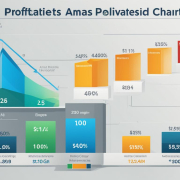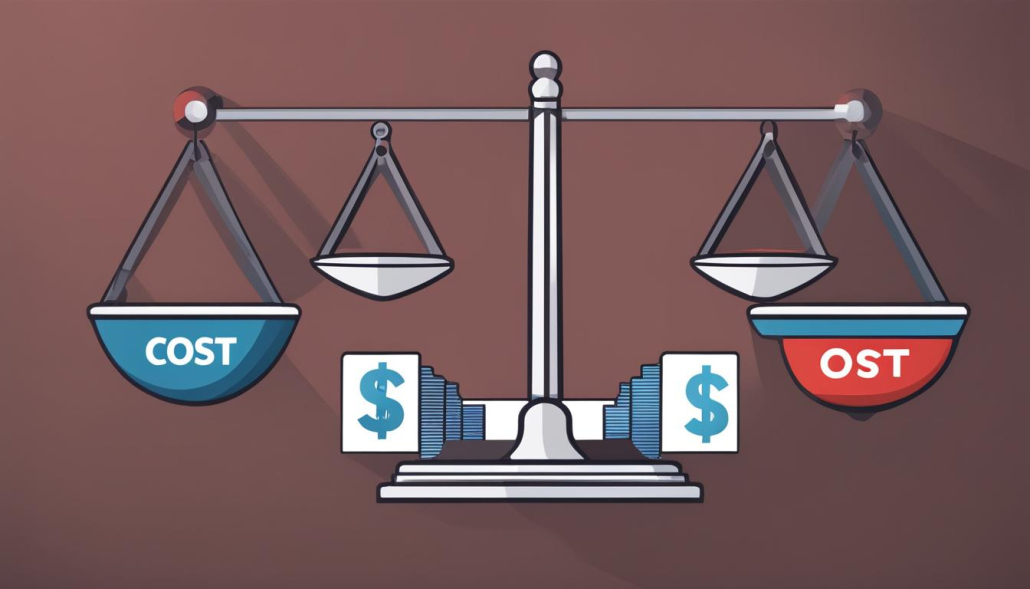Understanding What is Profitability – Key Insights
When I delve into the core of what drives a business’s success, I inevitably arrive at the concept of profitability. By definition, profitability represents a company’s capability to yield financial gains well beyond its expenditures. For anyone immersed in the intricacies of commerce, appreciating the meaning of profitability is crucial, not just as a figure on a spreadsheet, but as a comprehensive barometer of financial performance and health.
The essence of profitability lies in its reflection of a firm’s aptitude to convert revenue into earnings effectively. It’s the financial heartbeat that pulses through every successful business, providing indispensable insights into whether an enterprise can thrive, sustain its operations, or expand. For me, examining a business’s profitability isn’t simply about looking at numbers; it symbolizes the company’s capacity to create value in the competitive dance of markets.
Stepping beyond static numbers, profitability morphs into a dynamic tool. It serves to benchmark one’s financial health against both historical performance and peers within the same industry. Whether you’re an investor, analyst, or executive, comprehending the fine shades of profitability paves the way toward making informed decisions that influence business success.
Key Takeaways
- Profitability serves as a foundational metric of financial performance, indicating a business’s ability to generate earnings.
- Understanding profitability offers critical insights into a firm’s financial health and potential for growth.
- The term encapsulates a business’s efficiency in converting revenue into profit and its overall success.
- Digging into profitability ratios provides valuable comparisons with past company performance and industry standards.
- Mastering the meaning and application of profitability empowers stakeholders to foster value creation and drive sound investments.
Exploring the Profitability Definition
When we delve into what is profitability, we look beyond mere numbers signifying profits. Profitability encompasses a crucial construct and objective in the landscape of modern businesses—it echoes a company’s adeptness at delivering value over mere financial transactions. In this quest for a comprehensive grasp of profitability, I will dissect its core components and delineate its significance for business endurance.
Profitability in Financial Terms
In unequivocal financial terms, profitability epitomizes the ability of a company to effectively convert its operations and sales into profits. A critical aspect of understanding profitability hinges on the application of various financial metrics, the cornerstone being profitability ratios. These ratios serve as instruments for businesses to measure and evaluate their efficiency and capability to yield sustainable profit margins and shareholder value.
The Role of Profitability in Business Longevity
What truly demarcates a transient success from a perennial one is the streak of consistent profitability. The long-term survival, referred to here as business longevity, is considerably swayed by a firm’s profitability structure. Proficient management and strategic financial operations can be deduced from profitable quarters, signaling not just viability but a potential for growth and a commendable market standing.
As I proceed further, I will unravel the nuances of profitability that fortify the foundation of thriving businesses. By equipping ourselves with an enlightened understanding of profitability, stakeholders can replicate these patterns of success, fostering a climate of sustainable growth and profitability.
How to Calculate Profitability
When I engage in profitability analysis, I place significant emphasis on understanding the core ratios and margins that reflect a company’s financial health. Among these, earnings calculation plays a pivotal role in discerning how effectively the business converts its actions into profits. Let’s delve into some of these methods and how they’re calculated to give you a clearer picture of financial analysis strategies.
The most basic step in how to calculate profitability is through the gross profit margin. It is computed by subtracting the cost of goods sold (COGS) from total sales revenue and dividing the result by total sales revenue. The outcome is a percentage representing the proportion of money left over from revenues after accounting for COGS.
Moving a step further, the operating margin comes into play. This involves taking the gross profit and subtracting operational costs such as wages, rent, and utilities. It then gets divided by your total revenue, providing insight into the efficiency of your business’s core operations.
The net profit margin takes into account not only the operational costs but also additional expenses such as taxes and interest. By subtracting these from your gross profit and dividing by total revenue, I can understand what percentage of revenue translates directly into profit.
In my profitability analysis, I also assess return on assets (ROA) and return on equity (ROE), which offer a more in-depth understanding of how well a company uses its assets to generate earnings and the extent to which equity supports profit growth, respectively.
| Profitability Metric | Formula | Purpose |
|---|---|---|
| Gross Profit Margin | (Total Revenue – COGS) / Total Revenue | Measure efficiency in production and pricing |
| Operating Profit Margin | (Operating Income) / Total Revenue | Gauge efficiency of core business operations |
| Net Profit Margin | (Net Income) / Total Revenue | Assess overall profitability after all expenses |
| Return on Assets (ROA) | (Net Income) / Total Assets | Evaluate asset utilization in generating profit |
| Return on Equity (ROE) | (Net Income) / Shareholders’ Equity | Measure profitability from shareholders’ perspective |
I also consider cash flow margin, which shows the efficiency of a company in converting sales into cash. It provides an understanding of the company’s liquidity and financial flexibility, which is vital for meeting short-term obligations and planning future investments.
Critical to success in financial analysis is recognizing that these ratios don’t stand alone; they must be compared against industry standards and historical performance to derive meaningful conclusions about a company’s financial state.
In conclusion, conducting a proper profitability analysis is a multi-faceted process that requires an in-depth look at various financial metrics. By using the aforementioned ratios and margins, I can paint a comprehensive picture of a company’s financial performance and potential earnings growth.
Importance of Profitability in Businesses
As someone deeply invested in the entrepreneurial world, I’ve observed time and again the importance of profitability as a cornerstone for sustaining and growing a business. It’s not simply about the numbers—profitability serves as a beacon of business efficiency, showcasing a firm’s ability to judiciously manage resources and turn a considerable profit. The way a company approaches profitability can often dictate its overall strategic direction and capacity for value creation.
Profitability as a Measure of Efficiency
Aiming for optimal profitability, diligent companies employ it as a key performance indicator—one that lays bare their strengths and opportunities in generating earnings. Fiscally speaking, a profitable end result is the byproduct of a finely tuned balance between revenues and expenses, indicating that the enterprise understands and skillfully handles its financial playbook. These figures help me, as a stakeholder, assess how adeptly my investments are being managed.
Profits and Business Decision Making
Another area where profitability takes center stage is in the realm of decision making. Whether it’s about expansion, product development, or market penetration, entrepreneurs rely on profitability insights to chart their course. Profitable businesses wield the dual advantages of investor confidence and financial leeway to embark on new ventures or bolster their operational capacities. This strategic edge is invaluable for long-standing market presence and paves the way for ongoing profitability and value creation.
Ultimately, I see profitability as a litmus test for a company’s financial health—a diagnostic tool that aids in forecasting the potential for future success. Recognizing its pivotal role helps businesses and investors alike navigate the ever-changing tides of the economic sea with a more competent, assured hand.
Types of Profitability Ratios Explained
Exploring the landscape of financial metrics, I find that types of profitability ratios are pivotal for any in-depth analysis of a company’s performance. These ratios come in two principal forms – margin ratios and return ratios – each set providing unique and invaluable perspectives on a enterprise’s financial standing. Let’s dive into what each of these encompasses.
Margin Ratios: From Gross to Net Profit Margin
Beginning with margin ratios, these essential indicators dissect the profitability of a company at varying levels of operation. The gross profit margin, for instance, offers a view into the percentage of revenue that exceeds the cost of goods sold, serving as a fundamental measure of production efficiency. Conversely, net profit margin examines what remains after all expenses have been subtracted from total revenue, signifying overall company efficacy. These calculations are straightforward yet powerful; they intricately detail a company’s ability to manage both direct and indirect costs.
Return Ratios: ROA, ROE, and ROIC
Return ratios step into the realm of investment efficiency – how wisely a company deploys its resources. For example, return on assets (ROA) quantifies a firm’s ability to translate investments in assets into profit, while return on equity (ROE) measures the profitability generated by shareholders’ investments. Lastly, the return on invested capital (ROIC) showcases the returns achieved from both debt and equity investments. These ratios not only gauge current performance but also inform predictions about future financial resilience.
In assessing the performance of a business, I often create a table to visualize the differences and trends across these critical profitability metrics. This table is not merely a collection of percentages but a narrative of fiscal health and strategic acumen. Let’s take a look at a illustrative example:
| Profitability Ratio | Description | Significance |
|---|---|---|
| Gross Profit Margin | The proportion of revenue remaining after COGS. | Indicates production and direct cost efficiency. |
| Net Profit Margin | Remaining income after all expenses. | Reflects overall organizational profitability. |
| Return on Assets (ROA) | Profit generated from total assets. | Measures asset utilization efficiency. |
| Return on Equity (ROE) | Profit generated from shareholders’ equity. | Evaluates shareholder investment efficiency. |
| Return on Invested Capital (ROIC) | Profits relative to total capital invested. | Assesses overall investment efficiency. |
These figures can help us identify which areas of operation require improvement and serve as a guidepost for strategic financial decision-making. The nuances in each ratio can be quite telling – a low net profit margin, for example, might indicate a need for cost reduction strategies or price adjustments.
As I delve deeper into these ratios, I’m consistently reminded of their profound implications – on the operations being scrutinized, the management strategies being evaluated, and ultimately, the financial decisions being made. A mastery of these profitability ratios not only depicts a business’s fiscal narrative but also charts a course for its financial trajectory.
The Insightful World of Profitability Analysis
As a professional deeply entrenched in the world of finance, I comprehend the substantial significance of profitability analysis. It is much more than a mere evaluation of numbers; it’s a strategic tool that goes beyond analyzing profits and paves the road for sustainable business growth. In my experience, dissecting business revenue streams and pinpointing areas for expense reduction are essential for maximizing gains. This is why profitability analysis is a non-negotiable part of Enterprise Resource Planning (ERP). It effectively segments a company into its most profitable units, allowing us to drive business decisions with precision and foresight.
A case in point is the meticulous dissection of revenue streams. Understanding which products or services are the most profitable can lead to more focused marketing and sales strategies. Meanwhile, recognizing underperforming areas can prompt timely initiatives to either improve those segments or to consider their elimination.
By bringing about an incisive visibility into costs and revenue, profitability analysis stands as the linchpin in financial forecasting and strategic planning.
To illustrate how profitability analysis impacts financial decisions, let’s examine a table I compiled that provides an insightful comparison between key business segments:
| Business Segment | Revenue | Cost of Goods Sold (COGS) | Gross Profit Margin | Recommendations for Improvement |
|---|---|---|---|---|
| Product A | $500,000 | $150,000 | 70% | Scale production to capitalize on high margin |
| Service B | $200,000 | $120,000 | 40% | Assess market demand, consider price adjustment |
| Product C | $80,000 | $75,000 | 6.25% | Consider discontinuing or re-evaluating suppliers |
Upon analyzing the data, decisive steps can be taken to boost the profitability of each segment. From expense reduction tactics in procurement to innovative ways to extract more value from the top earners, the insights gleaned can dictate the trajectory of future business undertakings.
- Target high-margin products and services for expansion.
- Implement cost-cutting strategies in low-margin areas.
- Identify waste and redundancies and eliminate them to further profit margins.
What is Profitability: Diving into Margin Ratios
When you examine the financial health of a business, understanding the various margin ratios is pivotal. These ratios offer insights into profitability in business by breaking down earnings relative to sales and expenditures. Let’s expose the layers of complexity behind the key margin ratios, including gross margin, operating margin, and pretax margin, to grasp their impact on overall profitability.
Understanding Gross Margin
Starting with the gross margin, it serves as a fundamental gauge of a company’s financial efficiency by comparing revenue against the cost of goods sold (COGS). Essentially, it reflects how well a company utilizes its resources to produce goods or services. A higher gross margin suggests that a company retains more revenue after accounting for the COGS, a sign of strong production and pricing strategies.
The Significance of Operating and Pretax Margins
Moving beyond the initial phase of production, the operating margin incorporates a wider range of costs, including sales, general, and administrative expenses. It measures how effectively a business can translate sales into operating profit, essentially putting a spotlight on operational efficiency and cost management.
Furthermore, the pretax margin is a robust indicator of profitability before the influence of tax policies. It reflects the effectiveness of a company’s overall management strategies, including its approach to expenses, pricing, and revenue generation. Higher pretax margins suggest that a business is proficient in keeping costs under control relative to its sales.
| Margin Type | Description | Impact on Profitability |
|---|---|---|
| Gross Margin | Revenue minus Cost of Goods Sold | Indicates production and pricing efficiency |
| Operating Margin | Operating Income divided by Revenue | Measures operational efficiency and cost management |
| Pretax Margin | Income before taxes divided by Revenue | Shows overall managerial effectiveness and sales control |
By meticulously analyzing these margin ratios, companies can strategically improve profitability by identifying areas of strength and targeting areas that need enhancement. Decisions on pricing, cost-cutting, and operational improvements can be informed by these crucial metrics, laying the groundwork for a more profitable future.
Factors Affecting Profitability in Various Industries
As I delve into the complexities of profitability within diverse industrial landscapes, it becomes increasingly clear that a myriad of variables play pivotal roles. From external economic factors to the precision of internal cost management, understanding these influences provides a vital edge in profitability improvement. Let’s explore how shifting dynamics exert influence on profit margins, and what decisions can fortify a company’s financial footing.
External Factors Influencing Profit Margins
Market trends serve as an omnipresent force, subtly dictating the direction of profitability through consumer behavior and demand shifts. Rivalry within industries can also sharpen the edge of competition, compelling businesses to innovate or risk obsolescence. Furthermore, broader economic conditions often have a direct correlation with profit margins, with phenomena like inflation and fiscal policies setting the stage for financial performance.
Internal Decisions and Their Impact on Profitability
Peering inward, the decisions made at the heart of a company can dramatically influence its profitability. Effective cost management not only trims excess but also reallocates resources toward more profitable ventures. Additionally, pricing strategies must strike a delicate balance between consumer appeal and revenue generation, a task that grows more challenging in hyper-competitive markets. Lastly, the continuous pursuit of operational efficiency aims to sculpt a leaner, more agile organization. Leveraging these internal dynamics is essential for a company determined to not just survive but thrive in today’s economic climate.
Improving Profitability: Strategies and Best Practices
As we explore the journey towards improving profitability, it’s fundamental to acknowledge the significance of both strategic cost management and innovation in driving profit optimization. Achieving an enhanced profit margin is not merely about cutting costs but also about rethinking and reinventing business practices to stay ahead in today’s competitive landscape.
Cost Management and Its Influence on Profits
The cornerstone of profit optimization lies in the careful analysis and management of cost structures. By implementing strategic cost management techniques, businesses can significantly reduce unnecessary expenditure without compromising on quality or productivity, thereby boosting their bottom line and profit margin enhancement.
- Lean Operations: Elimination of wasteful processes to enhance operational efficiency.
- Outsourcing: Partnering with specialized firms to lower operational costs for non-core activities.
- Negotiation: Procurement strategies that leverage volume to achieve better pricing from suppliers.
Innovation Tactics to Boost Profit Margins
On the other side of profit margin enhancement, innovation acts as a catalyst for growth and diversification. By fostering innovation in product development, customer experience, and business models, companies can unlock new revenue streams and market segments, setting themselves apart from the competition.
Implementing technological advancements and creative solutions can open doors to improving profitability through:
- Enhanced product features that cater to evolving consumer needs.
- Improved service delivery mechanisms that heighten customer satisfaction.
- Disruptive business models that redefine the market landscape.
Let’s break down some key areas where strategic changes can influence the profit margins:
| Area of Focus | Cost Management | Innovation |
|---|---|---|
| Operational Efficiency | Streamlining processes, automation | Implementing advanced technologies |
| Product Development | Value engineering, lean design | Customer-driven features, R&D |
| Market Expansion | Targeted marketing strategies | Exploring untapped markets, digital presence |
| Customer Engagement | Cost-effective service options | Personalization, enhanced user experiences |
In conclusion, while cost management is vital in maintaining a healthy profit margin, it’s the harmonious blend with creative innovation that truly maximizes profitability. By adopting this dual approach, companies can achieve a robust financial performance that not only leads to cost savings but also propels the business towards sustainable growth and success.
Profitability Ratio Analysis in Action
As a seasoned financial analyst, I often emphasize the importance of profitability ratio analysis as a cornerstone in evaluating a company’s financial stature. It’s not just a set of numbers; it’s an invaluable tool for financial decision-making, shaping business strategies, and conducting a thorough financial health assessment. Understanding the intrinsic value of these ratios, I guide business leaders to integrate analytical insights into actionable plans that drive fiscal prudence and visionary leadership.
- Return on Assets (ROA)
- Gross Profit Margin (GPM)
- Net Profit Margin (NPM)
- Return on Equity (ROE)
- Debt to Equity Ratio (DER)
These ratios are not mere statistics; they serve as the backbone for a company’s performance narrative, dissecting the efficacy of operations, resource allocation, and even the scope of market competitiveness. I’ve employed such analysis in various consulting projects to herald new phases of profitability and sustainability.
Let’s consider a practical example of these ratios at work.
| Ratio | Purpose | 2019 | 2020 | 2021 |
|---|---|---|---|---|
| ROA | Gauge asset efficiency | 5.6% | 6.4% | 7.1% |
| GPM | Measure sales profitability | 22% | 24% | 23.5% |
| NPM | Reflect net earnings | 8% | 9% | 10.2% |
| ROE | Assess shareholder earnings | 12% | 13.2% | 15% |
| DER | Debt to equity balance | 1.2 | 0.9 | 0.7 |
By juxtaposing these figures across three fiscal periods, it becomes evident how the dynamic of profitability evolves, highlighting areas of strength and pinpointing sectors needing scrutiny. For instance, the ROE’s steady climb reflects an enhancing value proposition to shareholders—a testament to refined business strategies and operational mastery.
But numbers alone don’t tell the complete story. Insightful interrogation of this data, considering market trends and economic shifts, reveals more nuanced interpretations. An uptick in ROA might signify improved asset utilization, while a lionized DER could indicate a strategic move towards less leveraged, more sustainability-focused operations.
In my role, the gravitas of these ratios culminates in advising on, not just the financial health of entities, but on the visionary paths they might tread towards future success. It is the amalgamation of numerical mastery and strategic foresight that distinguishes the proficient from the exceptional in financial leadership.
Case Studies: Profitability Success Stories
The journey to strategic growth and remarkable financial performance is often documented through insightful case studies. I’ve seen firsthand how businesses leverage profitability metrics to make pivotal decisions, resulting in profitability turnarounds that serve as empowering success stories. Delving into these real-world case studies, I’ve noticed a pattern of transformation where the focused use of profitability ratios becomes the compass for strategic decisions leading to exponential growth.
Utilizing Profitability Ratios for Strategic Growth
Companies like Apple and Amazon have shown how profitability ratios can inform strategic growth measures. These enterprises use ratios to understand not only where they stand, but also to predict future performance and make adjustments for sustained success. Through rigorous financial analysis, they’ve crafted strategies that consistently push the envelope in technological innovation and consumer experience.
Lessons Learned from Profitability Turnarounds
On the flip side, stories of profitability turnarounds such as those experienced by Best Buy and Starbucks highlight the resilience of a business model pivoting at the right moment. Each case underscores the significance of timely actions, whether it be revamping retail strategies or reinventing brand presence. The transformative power of profitability ratios in these turnarounds cannot be overstated; they are the evidences of financial acumen par excellence.
| Company | Challenge | Action Taken using Profitability Ratios | Result |
|---|---|---|---|
| Best Buy | Rising competition from online retailers | Optimized cost structure and expanded online presence | Improved net profit margin and market share growth |
| Starbucks | Saturated markets and brand fatigue | Rebranding and introduction of premium products | Increased operating margin and global brand revitalization |
Conclusion
In the journey through understanding and summarizing profitability, I’ve uncovered the vital role this concept plays in determining business performance and potential for financial success. By dissecting the factors that contribute to profitability, from revenue generation to cost management, it becomes clear that the full picture of a company’s financial health transcends simple earnings reports. The use of various profitability ratios enables businesses to fine-tune their financial strategies, ensuring a stronger profitability outlook.
The practice of calculating and analyzing profitability serves far more than a retrospective glance at financial statements. It engages companies in proactive management of their assets, operational efficiency, and value creation, knitting together a comprehensive strategy to bolster their standing in the competitive market. The insights provided by profitability analyses are more than mere numbers; they are a beacon guiding firms towards a brighter financial future.
My exploration has cemented a conviction that a robust understanding of profitability is not just beneficial but essential. It lays the groundwork for meaningful business growth and a sustainable competitive edge. Looking ahead, the principles of profitability should remain at the forefront of strategic planning to forge a pathway to enduring financial triumph. For any business aspiring to thrive, maintaining a keen eye on profitability is the compass that ensures they chart a successful course.
FAQ
What is profitability in the context of a business?
Profitability is a measure of a company’s ability to generate earnings relative to its revenue, operating costs, and financial aspects. It reflects a business’s financial performance and health, indicating how effectively it generates profit and creates value for shareholders.
How do financial terms define profitability?
In financial terms, profitability represents a company’s capability to generate profit from its sales, operations, and the investments of shareholders. It typically involves financial metrics such as profitability ratios to evaluate a company’s efficiency in yielding profit and maintaining financial stability.
Why is profitability important for business longevity?
Profitability is crucial for business longevity as it signifies a company’s adeptness at managing resources, sustaining operations, and creating value for shareholders. It provides insights into management performance and influences strategic decision-making, essential for long-term success and growth.
What methods are used to calculate profitability?
To calculate profitability, various ratios and margins are used, such as gross margin, operating margin, net profit margin, return on assets (ROA), return on equity (ROE), and cash flow margin. These methods assess the company’s efficiency and effectiveness at different operational levels using data on sales revenue, costs, operating expenses, and net income.
How does profitability impact business decision-making?
Profitability influences business decision-making by guiding strategies and investments. Companies that are more profitable can better manage costs, maximize returns for shareholders, and fuel growth and competitiveness, which are essential for making informed, strategic business decisions.
What are margin ratios and how do they relate to profitability?
Margin ratios, such as gross margin, operating margin, and net profit margin, assess a company’s profitability at various stages of operations. These ratios indicate how well a company converts sales into profits after accounting for costs and operating expenses.
What are return ratios and why are they important?
Return ratios, like return on assets (ROA), return on equity (ROE), and return on invested capital (ROIC), measure how effectively a company is utilizing its assets and investments to generate returns for shareholders. They are key indicators of a company’s financial health and performance.
Can you explain what profitability analysis entails?
Profitability analysis involves reviewing a company’s revenue streams and expenses to maximize profits. This analysis can identify profitable segments within the business, highlight areas for cost reduction, and help stakeholders understand the various factors that contribute to the company’s profitability.
What external factors can affect a company’s profitability?
External factors affecting profitability include market trends, competition, and economic conditions. These can have different impacts on profit margins across various industries and are crucial to monitor for adapting business strategies accordingly.
How can a company’s internal decisions influence profitability?
Internal decisions involving cost management, pricing strategies, and operational efficiency are pivotal in determining a company’s profitability. Making the right decisions in these areas can improve profitability and support long-term growth.
What strategies can companies use to improve profitability?
Strategies to improve profitability include strategic cost management to reduce production expenses and innovation in processes, products, and business models to increase sales and market differentiation. These actions can enhance profitability by increasing margins and standing out in the marketplace.
How is profitability ratio analysis used in financial decision-making?
Profitability ratio analysis helps executives assess the effectiveness of business strategies and financial health by comparing current profitability with historical performance and industry benchmarks. This analysis is critical for making informed financial decisions regarding resource allocation and investment evaluation.
What can businesses learn from profitability case studies?
Businesses can gain valuable insights from profitability case studies, which showcase how other companies have used profitability ratios to facilitate strategic growth and orchestrate turnarounds. Lessons from these narratives inform comparable tactics that businesses can employ to enhance their own financial performance.
- About the Author
- Latest Posts
Cathy Berger is a member of the editorial staff at docurex.com









